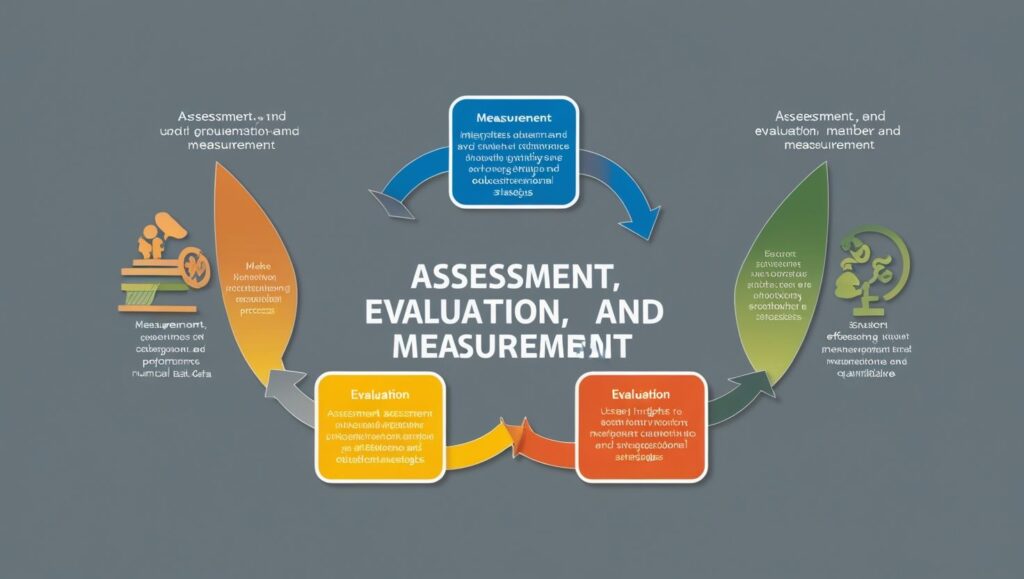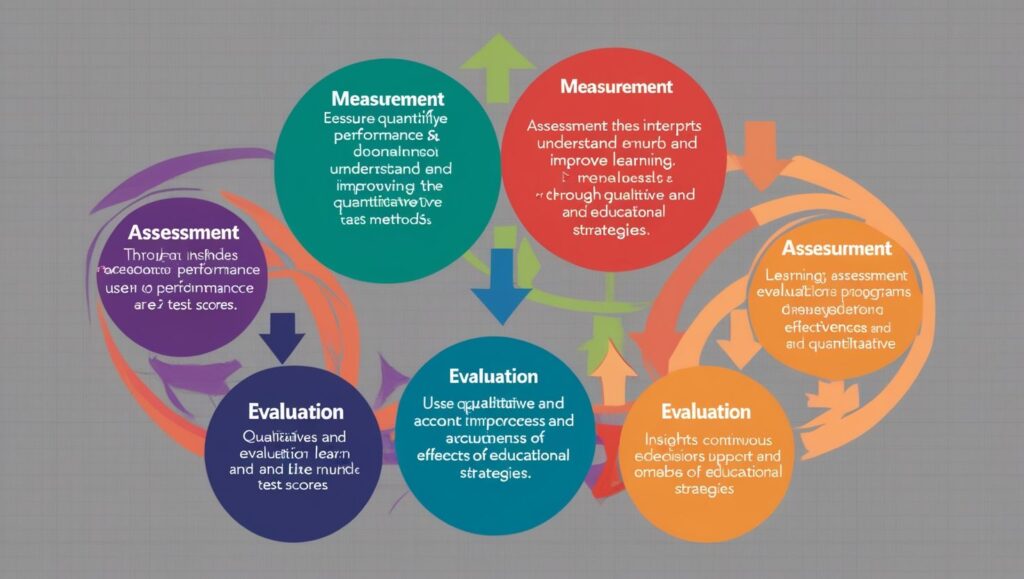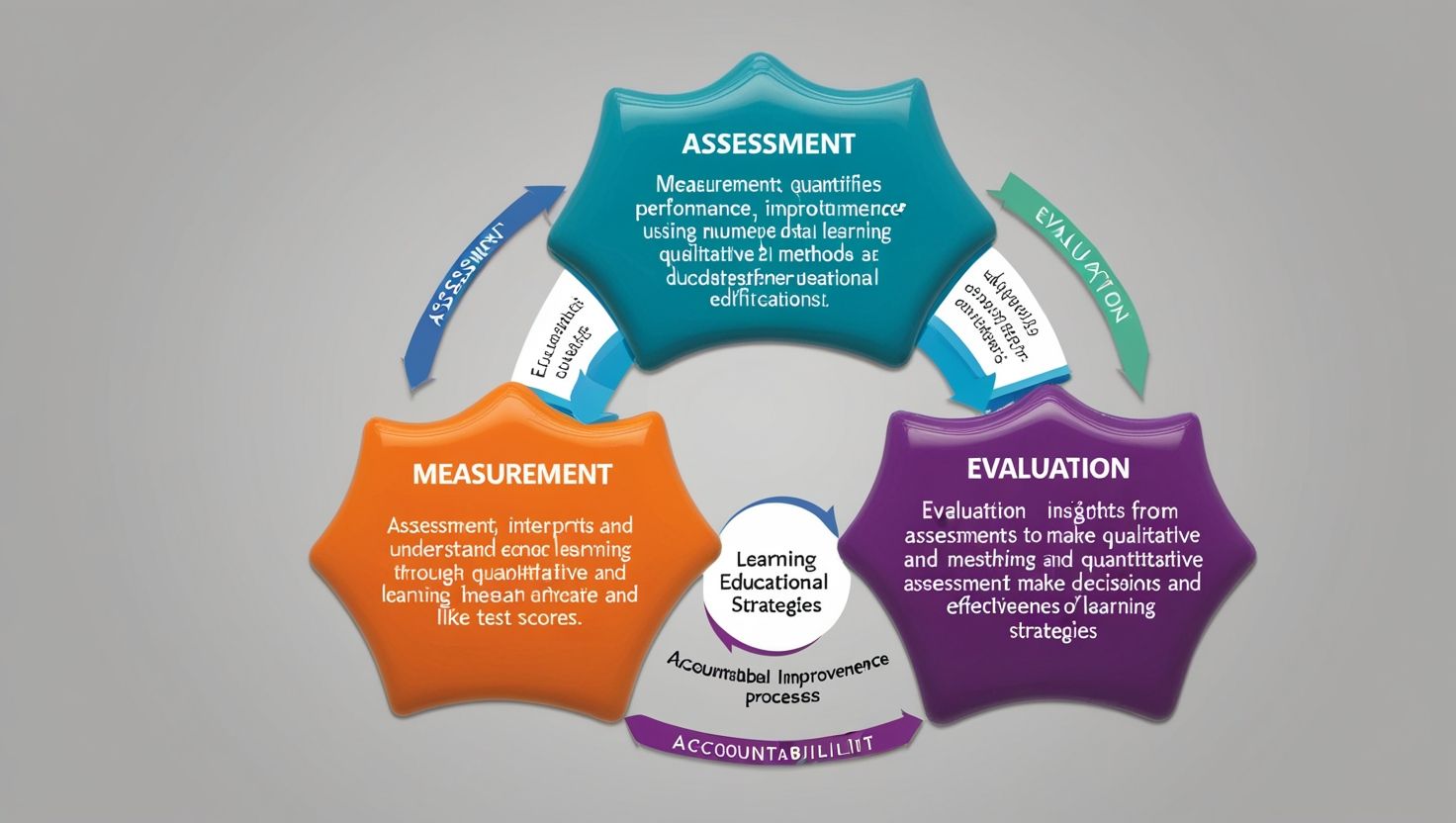Assessment, Evaluation, and Measurement, The terms assessment, evaluation, and measurement are often used interchangeably in educational and professional contexts. However, each has distinct characteristics and serves specific purposes in determining knowledge, skills, and performance. Understanding these distinctions is vital for educators, administrators, and stakeholders who aim to improve learning outcomes effectively. This article explores their definitions, purposes, and practical applications while highlighting their differences.
Defining the Terms
Measurement
Measurement refers to the process of quantifying a learner’s knowledge, abilities, or characteristics using a numerical scale. It involves objective tools such as tests, quizzes, or standardized assessments, where results are expressed in numbers or scores.
- Example: A student scoring 85 out of 100 in a mathematics test reflects measurement.
- Characteristics:
- Quantitative in nature.
- Involves tools like rubrics, scales, or standard tests.
- Provides raw data for further analysis.
Assessment
Assessment encompasses a broader scope than measurement. It is a systematic process of gathering, analyzing, and interpreting information to understand a learner’s abilities, knowledge, or progress. Assessment can be formative (ongoing) or summative (final).
- Example: Analyzing students’ projects, classroom participation, and homework to gauge their understanding of a subject.
- Characteristics:
- Both qualitative and quantitative.
- Focuses on improving learning outcomes.
- Can include self-assessments, peer reviews, and teacher observations.

Evaluation
Evaluation is a decision-making process that uses information gathered from assessments and measurements to judge the value, effectiveness, or success of an educational program, instructional method, or individual performance.
- Example: Determining whether a teaching strategy effectively improved student engagement based on assessment results.
- Characteristics:
- Qualitative and judgment-based.
- Focused on decision-making and accountability.
- Emphasizes the effectiveness and value of processes and outcomes.
Key Distinctions
1. Purpose
- Measurement is used to collect numerical data. For instance, a test measures a student’s factual knowledge.
- Assessment aims to understand and improve learning. It identifies strengths, weaknesses, and areas for improvement.
- Evaluation focuses on making judgments about the effectiveness or quality of a program or method.
2. Scope
- Measurement is narrower, dealing only with the numerical aspect of performance.
- Assessment has a wider lens, incorporating both quantitative and qualitative insights to support learning.
- Evaluation has the broadest scope, including analysis of processes, outcomes, and implications.
3. Tools and Methods
- Measurement relies on instruments like tests, scales, and metrics.
- Assessment includes varied tools such as rubrics, observational checklists, interviews, and portfolios.
- Evaluation uses the results of both measurement and assessment alongside external criteria, such as benchmarks or educational standards.
4. Output
- Measurement produces quantitative data (scores, percentages).
- Assessment yields insights into student progress, providing actionable feedback.
- Evaluation results in judgments, recommendations, or decisions.
Interdependence Among the Three
Although distinct, assessment, evaluation, and measurement are interrelated:
- Measurement provides the numerical data that feeds into the assessment process.
- Assessment uses this data to analyze and interpret student learning.
- Evaluation uses assessment findings to make informed decisions or improve educational practices.
For instance, a teacher measuring student scores on a science test (measurement) might use the data to identify learning gaps (assessment). The teacher or school administration then evaluates whether the curriculum or teaching methods need revision (evaluation).
Types and Examples
Measurement Examples
- Recording the time taken by students to complete a task.
- Assigning grades based on correct answers in a quiz.
Assessment Examples
- Formative: Weekly quizzes, classroom discussions, and journal reflections.
- Summative: Final exams, research papers, and presentations.
Evaluation Examples
- Determining if a course’s objectives align with student outcomes.
- Analyzing a teacher’s effectiveness based on student performance and feedback.
Role in Education
Measurement in Education
- Provides objective data for comparisons, like standardized test scores.
- Offers benchmarks for setting performance goals.
Assessment in Education
- Promotes continuous learning by identifying specific areas for improvement.
- Encourages active participation through self and peer assessments.
Evaluation in Education
- Ensures accountability by examining the success of educational strategies.
- Guides policy-making by evaluating educational programs and initiatives.

Challenges and Limitations
Measurement
- May overlook qualitative factors like creativity or critical thinking.
- Can cause stress if overemphasized in high-stakes testing.
Assessment
- Time-intensive due to the need for detailed observation and feedback.
- May suffer from subjective bias in qualitative methods.
Evaluation
- Requires clear criteria to ensure validity and reliability.
- Can be resource-heavy, demanding skilled personnel and tools.
Practical Application
To illustrate their combined application, consider a scenario in a school:
- Measurement: Students complete a math test, and their scores are recorded.
- Assessment: The teacher analyzes the results to identify areas where most students struggled.
- Evaluation: The school reviews the overall teaching strategy and decides to incorporate new resources or training for teachers to address these weaknesses.
This interconnected process ensures effective learning and informed decision-making.
Emerging Trends
With advancements in technology and pedagogy, these processes are evolving:
- Digital Measurement Tools:
- Automated grading systems for faster and more accurate scoring.
- Data analytics for tracking student progress over time.
- Holistic Assessments:
- Use of e-portfolios to showcase student achievements.
- Increased emphasis on project-based learning and creativity.
- Comprehensive Evaluations:
- Integrating feedback from students, parents, and teachers.
- Use of AI to analyze educational strategies and predict outcomes.
Conclusion
While measurement, assessment, and evaluation serve distinct functions, their integration is essential for a well-rounded educational process. Measurement provides the data, assessment interprets it, and evaluation uses this interpretation to make informed decisions. Together, they foster an environment of continuous learning, accountability, and improvement, ensuring that education meets the needs of learners and society alike. Recognizing their differences and interconnections enables educators and policymakers to enhance educational practices effectively.

7 thoughts on “Assessment, Evaluation and Measurement”
Comments are closed.